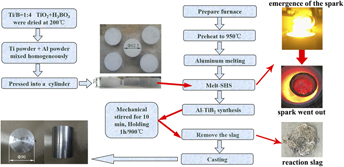Crossref Citations
This article has been cited by the following publications. This list is generated based on data provided by
Crossref.
Li, He
Wang, Xiaoming
Chai, Lihua
Wang, Haijing
Chen, Ziyong
Xiang, Zhilei
and
Jin, Tounan
2018.
Microstructure and mechanical properties of an in-situ TiB2/Al-Zn-Mg-Cu-Zr composite fabricated by Melt-SHS process.
Materials Science and Engineering: A,
Vol. 720,
Issue. ,
p.
60.
Wang, Haijing
Li, He
Chai, Lihua
Ma, Tiejun
Jian, Ningning
Jin, Tounan
Chen, Ziyong
and
Shi, Guodong
2018.
High Performance Structural Materials.
p.
891.
Azarniya, Amir
Azarniya, Abolfazl
Abdollah‐zadeh, Amir
Madaah Hosseini, Hamid Reza
and
Ramakrishna, Seeram
2019.
In Situ Hybrid Aluminum Matrix Composites: A Review of Phase Transformations and Mechanical Aspects.
Advanced Engineering Materials,
Vol. 21,
Issue. 7,
Pan, Yafei
Zhang, Cong
Zhang, Jiuxing
Huang, Lei
Yang, Xinyu
Du, Yong
and
Luo, Fenghua
2019.
Thermodynamic Modeling of the B-Ti-Zr System Over the Whole Composition and Temperature Ranges.
Journal of Phase Equilibria and Diffusion,
Vol. 40,
Issue. 3,
p.
364.
Dong, Yangping
Li, Yulong
Ebel, Thomas
and
Yan, Ming
2020.
Cost-affordable, high-performance Ti–TiB composite for selective laser melting additive manufacturing.
Journal of Materials Research,
Vol. 35,
Issue. 15,
p.
1922.
Huang, Jingcun
Xiang, Zhilei
Li, Jihao
Ma, Xiaozhao
Yang, Zian
Shen, Gaoliang
Wang, Zhitian
and
Chen, Ziyong
2021.
Effect on microstructure and mechanical properties of in situ 6 wt%TiB2/Al–Zn–Mg–Cu composite subjected by two-step orthogonal deformation process.
Journal of Materials Research,
Vol. 36,
Issue. 21,
p.
4426.
Yang, Zi An
Xiang, Zhi Lei
Chen, Zi Yong
Ren, Wei Min
Li, Zhong Hao
and
Tan, Chao
2021.
Research on Microstructure and Properties of TiB<sub>2</sub>/Al-Si Multi-Element Piston Alloy Composite.
Materials Science Forum,
Vol. 1035,
Issue. ,
p.
892.
Gao, Tong
Liu, Lingyu
Liu, Guiliang
Liu, Sida
Li, Chunxiao
Li, Mengyu
Zhao, Kai
Han, Mengxia
Wu, Yuying
and
Liu, Xiangfa
2022.
In–situ synthesis of an Al–based composite reinforced with nanometric γ–Al2O3 and submicron AlB2 particles.
Journal of Alloys and Compounds,
Vol. 920,
Issue. ,
p.
165985.
Gao, Tong
Liu, Lingyu
Li, Mengyu
Sun, Yue
Wu, Yuying
and
Liu, Xiangfa
2023.
Design of Al based composites reinforced with in–situ Al2O3, AlB2 and Al13Fe4 particles.
Composites Communications,
Vol. 40,
Issue. ,
p.
101629.
Li, Mengyu
Li, Chunxiao
Hu, Jingyi
Liu, Guiliang
Han, Mengxia
Gao, Tong
and
Liu, Xiangfa
2024.
Modify the interface between ex-situ γ-Al2O3 and Al matrix via in-situ coating in an Al matrix composite.
Composites Communications,
Vol. 47,
Issue. ,
p.
101860.
Fu, Shuting
Han, Ying
Sun, Jiapeng
Qiu, Feng
Zu, Guoqing
Zhu, Weiwei
and
Ran, Xu
2025.
Study on the microstructure and mechanical properties of selective laser melted TiB/Ti6Al4V composites incorporating trace amounts of TiB2 nanoparticles.
Journal of Alloys and Compounds,
Vol. 1013,
Issue. ,
p.
178485.
